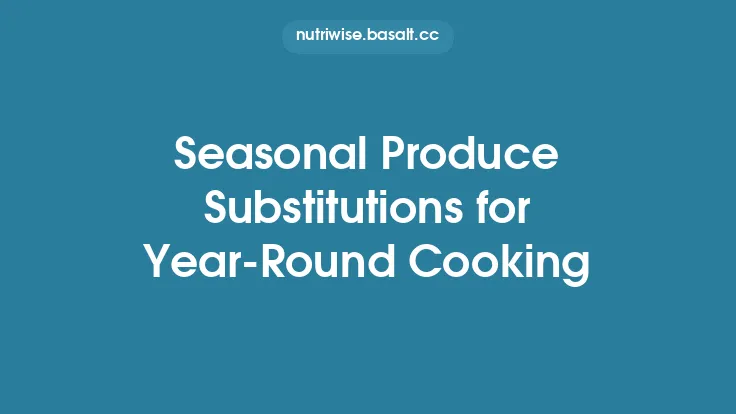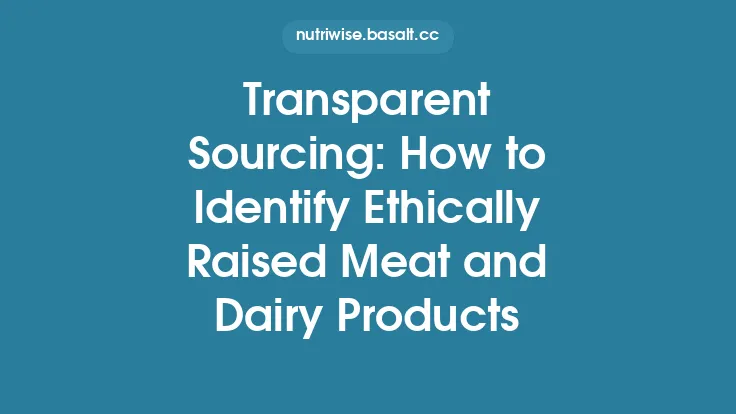Local produce is the cornerstone of a resilient food system, yet many shoppers assume that “local” automatically means “seasonal” and therefore only available during a narrow window each year. In reality, a combination of regional climate knowledge, modern growing techniques, and reliable sourcing tools makes it possible to identify and choose truly local fruits, vegetables, herbs, and even animal products throughout the entire calendar year. This guide walks you through the practical steps, technical considerations, and decision‑making frameworks you need to consistently select high‑quality, locally sourced foods no matter the month.
Understanding Your Regional Growing Zone
USDA Hardiness Zones and Their Limits
The United States Department of Agriculture (USDA) divides the country into 13 hardiness zones based on average annual minimum winter temperatures. While these zones were originally designed for ornamental horticulture, they provide a quick reference for what can be grown outdoors without protection. Knowing your zone (e.g., Zone 7a for much of the Mid‑Atlantic) tells you which crops can survive the winter outdoors and which will need season‑extension methods.
Microclimates Within a Single Region
Even within a single hardiness zone, microclimates—variations caused by elevation, proximity to bodies of water, urban heat islands, or wind patterns—can shift planting windows by several weeks. Mapping local microclimates (often available through county extension services) helps you pinpoint neighborhoods where early‑season strawberries or late‑season kale may be viable.
Climate‑Based Crop Calendars
Most state extension offices publish “crop calendars” that list the typical planting, harvesting, and peak availability dates for major produce groups. These calendars are evergreen resources; they are updated annually based on observed weather patterns, not on a fixed date. By consulting the most recent version, you can anticipate which crops should be in season now and which are likely being grown under protected conditions.
Season‑Extension Techniques That Keep Local Produce Available Year‑Round
High Tunnels and Hoop Houses
These low‑tech structures use clear plastic coverings to trap solar heat, extending the growing season by 4–8 weeks. Crops such as tomatoes, peppers, and leafy greens can be started earlier in spring and harvested later in fall. Because the structures are typically owned by local farms, the produce remains “local” even when it appears out of its traditional season.
Cold Frames and Row Covers
For small‑scale growers, cold frames provide a modest amount of frost protection, allowing hardy greens (e.g., spinach, arugula) to be harvested well into winter. Row covers—fabric or plastic sheets draped over beds—can similarly raise ambient temperatures by a few degrees, making it possible to grow crops like carrots and beets during colder months.
Greenhouse Production
Commercial greenhouse operations in many regions grow tomatoes, cucumbers, peppers, and herbs year‑round. While the energy inputs are higher, the produce is still considered local if the greenhouse is within the same county or metropolitan area. Look for labeling that specifies the greenhouse’s location rather than a generic “imported” tag.
Indoor Vertical Farming and Hydroponics
Urban farms that employ vertical stacking, LED lighting, and nutrient‑film technique (NFT) hydroponics can produce leafy greens, herbs, and microgreens continuously. Because these farms often operate in repurposed warehouses within city limits, the output qualifies as local despite the high‑tech production method.
Aquaponics and Integrated Systems
Aquaponic systems combine fish farming with hydroponic plant production, creating a closed‑loop ecosystem. Many community‑based aquaponic farms supply salad greens and herbs to nearby grocery stores and restaurants throughout the year. Their dual‑product nature (fish and produce) underscores the importance of verifying the farm’s physical location when assessing locality.
Tools for Verifying the Origin of Produce
PLU (Price Look‑Up) Codes
Most fresh produce carries a four‑digit PLU code. Codes beginning with 9 indicate organic items, while those starting with 8 denote genetically modified produce. The remaining three digits identify the specific fruit or vegetable, but they do not directly reveal origin. However, many retailers add a supplemental two‑digit suffix (e.g., “01”) that corresponds to a regional identifier in their internal system. Asking a store associate about the suffix can clarify whether the item is sourced locally.
QR Codes and Blockchain Traceability
A growing number of farms embed QR codes on packaging or stickers on bulk produce. Scanning the code can pull up a digital ledger that lists the farm’s name, exact field location (latitude/longitude), harvest date, and any certifications. Some producers use blockchain platforms (e.g., IBM Food Trust) to ensure the data cannot be altered, providing a high level of confidence in the claim of locality.
Certification Labels
- Certified Local: Some state agricultural departments offer a “Certified Local” label for products grown and processed within a defined radius (often 100 miles).
- Farm‑Fresh: While not a regulated term, many cooperatives use “Farm‑Fresh” in conjunction with a verified farm list posted on their website.
- Organic + Local: When a product bears both the USDA Organic seal and a local certification, you can be reasonably sure it meets both standards.
Direct Vendor Communication
When shopping at farmers’ markets, farm stands, or CSA pick‑up points, ask the grower directly about the production method (open field vs. greenhouse) and the exact location of the field. Most growers are eager to share this information, especially if they practice transparent sourcing.
Building a Reliable Network of Local Suppliers
Community‑Supported Agriculture (CSA) Shares
CSAs operate on a subscription model where members receive a weekly or bi‑weekly box of produce harvested from the farm’s current crop. Because the farm determines the mix based on what is actually growing, CSA members automatically receive seasonally appropriate, locally grown items throughout the year. Many CSAs also rotate in greenhouse or high‑tunnel produce during off‑season months, maintaining year‑round availability.
Farm‑to‑Retail Partnerships
Some regional grocery chains partner directly with nearby farms, bypassing large distributors. These partnerships are often highlighted in store signage (“Locally Grown in XYZ County”). Inquire at the produce manager’s desk for a list of participating farms and the expected delivery schedule.
Food Hubs and Aggregators
Food hubs act as intermediaries that aggregate produce from multiple small farms, handle logistics, and deliver to retailers, restaurants, or directly to consumers. Because they maintain detailed sourcing records, you can request a “local produce list” that specifies which farms supplied each item during a given week.
Online Farm Directories
Websites such as LocalHarvest, Farmigo, and state‑specific farm directories allow you to search by commodity, location, and production method. Many of these platforms include real‑time inventory updates, enabling you to place orders for items that are currently in season locally.
Criteria for Selecting High‑Quality Local Produce
Visual Indicators
- Color Uniformity: A consistent, vibrant hue usually signals proper ripeness and minimal stress during growth.
- Skin Integrity: Look for smooth, unblemished skins on fruits and firm, uncracked surfaces on root vegetables.
- Leaf Turgidity: For leafy greens, bright, crisp leaves that snap when bent indicate freshness.
Tactile Assessment
- Firmness: Gently press the fruit or vegetable; it should yield slightly but not feel mushy.
- Weight: Heavier items for their size often contain higher water content, a sign of recent harvest.
Olfactory Cues
- Aromatic Freshness: Many herbs and ripe fruits emit a strong, pleasant scent when freshly harvested. A lack of aroma can suggest age or improper storage.
Harvest Date Transparency
When available, note the harvest date printed on packaging or provided by the vendor. Produce harvested within the past 48 hours typically offers the best flavor and nutritional profile, regardless of the season.
Ethical Production Practices (Beyond “Local”)
While the focus here is on locality, many consumers also consider pesticide use, water stewardship, and labor standards. If these factors matter to you, prioritize farms that publish their Integrated Pest Management (IPM) plans, water usage data, or third‑party labor certifications alongside their locality claims.
Managing Seasonal Gaps Without Compromising Locality
Even with extensive season‑extension, a few niche items may experience brief gaps. Here are strategies to maintain a fully local basket:
- Rotate Between Multiple Farms – If one farm’s greenhouse is offline for maintenance, another nearby operation may have the same crop in production.
- Utilize Different Production Systems – Combine open‑field, greenhouse, and indoor vertical farm sources to cover the entire calendar.
- Plan for Overlap – Many crops have overlapping harvest windows (e.g., early‑season kale from open fields and late‑season kale from high tunnels). By purchasing from both sources, you smooth out availability.
- Leverage Local Storage – Some farms employ controlled‑atmosphere (CA) storage for apples, pears, and root vegetables, extending their marketable life while keeping the product within the region.
Practical Workflow for the Year‑Round Shopper
- Map Your Region – Identify your USDA zone, microclimates, and any nearby farms using extension bulletins.
- Create a Supplier List – Include CSAs, farm stands, local food hubs, and grocery stores with verified local sourcing.
- Set Up Alerts – Subscribe to farm newsletters, QR‑code updates, or mobile apps that push notifications when a new batch of a desired crop arrives.
- Verify Each Purchase – Scan QR codes, ask for harvest dates, and check PLU suffixes to confirm locality.
- Assess Quality – Use visual, tactile, and olfactory checks before finalizing the purchase.
- Record and Review – Keep a simple log of where each item came from and its perceived quality; over time, this helps you refine your supplier network.
Frequently Overlooked Sources of Local Produce
- University Research Farms – Many land‑grant universities operate demonstration farms that sell produce to the public. Their crops are often grown using cutting‑edge season‑extension methods.
- Community Gardens – In urban neighborhoods, community garden plots sometimes sell surplus harvests at pop‑up stands. These are hyper‑local, often within walking distance.
- Restaurant‑Backed Farm Boxes – Some farm‑to‑table restaurants offer “chef’s box” subscriptions that include the same ingredients used in their seasonal menus.
- Mobile Farm Stands – Trucks or vans that travel between neighborhoods, delivering fresh produce directly from nearby farms.
Conclusion
Identifying and choosing local produce throughout the year is less about luck and more about a systematic approach that blends regional climate knowledge, modern growing technologies, and transparent sourcing tools. By understanding your growing zone, recognizing the role of season‑extension methods, leveraging QR‑code traceability, and building a diversified network of local suppliers, you can consistently fill your kitchen with fresh, high‑quality foods that truly belong to your community—no matter the month. This not only supports a resilient local food system but also ensures that the flavors on your plate reflect the genuine bounty of your own region.





